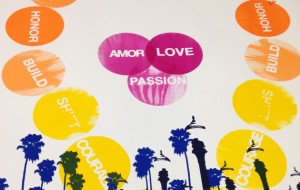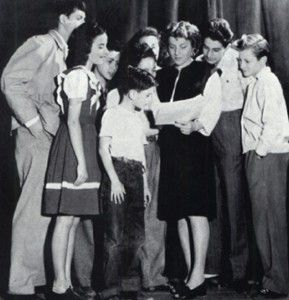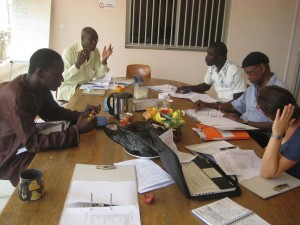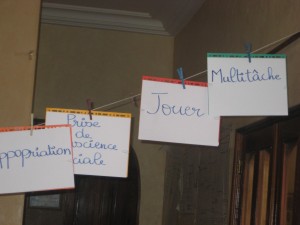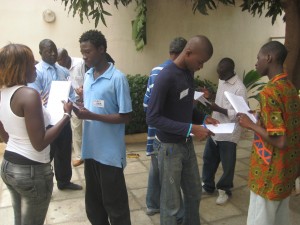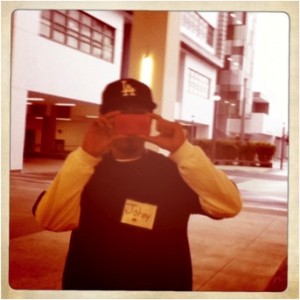 These eulogies were given by my uncle, mother, aunt, father, and myself at the December 24, 2013, memorial service for my grandmother, Ruth Marcus. She had died two days prior, in her home and in the presence of her family, at the age of 91 and a half. Her cousin Beverly Copeland also created a written tribute for Ruth.
These eulogies were given by my uncle, mother, aunt, father, and myself at the December 24, 2013, memorial service for my grandmother, Ruth Marcus. She had died two days prior, in her home and in the presence of her family, at the age of 91 and a half. Her cousin Beverly Copeland also created a written tribute for Ruth.
Dick Marcus
For the last several years, Mom and I would go out for lunch each Saturday. One of our favorite spots was Georgie V’s, a pleasant breakfast and lunch diner in Northbrook. At some point, I guess, we became regulars, known to the waiters and waitresses and bus boys as well as the restaurant owner, George Vlhalkis. On several occasions, after chatting with my mom, George would put his large hand on my shoulder and tell me that he wished all his customers could be like my mother.
I would smile and nod, knowingly. But there was a part of me that was thinking, “Whoa, George…Be careful what you wish.”
I would be thinking that if all of his customers were like my mother, the first thing George would need to do would be to throw away his reservation book. It would be worthless. To my mom, appointment times, movie times, event times, reservation times, were more like suggestions, more like ranges. And the older she got, the longer those ranges became. Mom just couldn’t be rushed, it just wasn’t her way.
And while he was at it, George might as well have tossed his menus too. Why? Because they would just be a nuisance. Listen. When mom went to Georgie V, she used to pick up the impressive six page menu and study it closely, intensely like a Talmudic scholar searching for clues to the meaning of life. And then, finally, she would order, yet again, two scrambled eggs. Which she wouldn’t eat. You see, to my mom, going to a restaurant, or gathering for a holiday feast for that matter, had nothing to do with eating. The food was irrelevant. Merely a prop. The importance was that we were together, talking, laughing, telling stories. So, no need for menus. Scrambled eggs for everyone.
And finally I’d think that George would need to double his staff. You see people like my mother attract a gathering of waitresses and busboys to their tables. They trade stories and catch up. George would need a lot more help then to keep the coffee cups filled and the orders taken.
But in truth, of course, I know what George meant. Actually, anyone who knew my mother at all knows what he meant. George meant that he wished all his customers walked into his restaurant with a smile as broad and bright as my mom’s. With a smile like a billboard broadcasting the message “It’s good to see you, good to be here at this moment, in this place, with all of you.” That smile of my mom’s was contagious and disarming. Even strangers were compelled to smile back at my mom, perhaps just out of courtesy, but maybe because my mom’s smile somehow tickled them, somehow reminded them that warm and kind people still walk the earth.
And George meant that he wished all his customers were, like my mom, quicker to compliment than to criticize. More inclined to point out the positive than to dwell on the negative. And, like my mom, believing that tone and temper should be thoughtfully calibrated to fit the situation. So that, if a customer needed to tell a waitress that the soup was too cold, then, like my mom, the customer would say it with a light touch, understanding that we are only talking about soup, not life or death.
And, I think that George meant that he even wished all his customers had my mom’s special talent, her special affinity, for putting people at ease and engaging them in conversation. I think he wished that all his customers had mom’s ability to listen to other people with an interest that was understanding and sincere. Indeed, wherever my mom went, including George’s crowded restaurant, mom could strike up a conversation with someone, and, more often than not, learn about the other person’s family, the person’s job, the person’s aspirations.
You see, Mom understood that every person’s life was a story, that every person’s life had its share of pathos, comedy, and drama. And by her asking a few questions and taking a few minutes to let a person share a bit of their life’s story with her, mom was affirming that that person’s life story was interesting, that it had value, that it was worth taking the time to hear. And who isn’t flattered a bit by something like that?
Mom’s smiles, kind words and friendly ear were not reserved to Georgie V’s of course. They were a part of her wherever she went. They were her gifts to all she met. Her contribution to making the world just a little bit brighter, a little bit happier. Indeed, you may find it fitting sometime during these next few days or weeks to pass a greeting on to someone you don’t know, or to take an extra moment to listen to someone’s story. I believe it would honor mom. And you might find it easier to do than you think, and more rewarding than you know.
Barbara Marcus Felt
I’ve been reflecting on my mom’s life lately and, these past few days, on her death.
I’ve been asking myself, “What did she want to teach me? And what have I learned?”
An anecdote keeps coming to mind. My mom had this habit that used to irritate my Aunt Audrey to no end. After my mom had finished washing her hands in a public ladies’ room, she would take a paper towel and wipe the sink area. The stray splashes on the counter and droplets on the faucet – my mom wiped ‘em all up. In a public washroom. After her hands were clean. My aunt would go crazy and even I would be mildly irritated because, usually, we’d be late to go somewhere.
I used to admonish her, “Mom, what are you doing???”
And she’d turn to me and say, “Barb, you have to leave it a little better than you found it.”
I think that’s the lesson that my mom meant for me to learn: As we go through life, we have to leave it a little better than we found it.
Sue Milner Marcus
I’ve had the privilege of knowing Ruth for over 44 years, for 7 years as Dick’s girlfriend (although he would never admit to that at the time), and for 37 years as her daughter-in-law. Now, many people love to make comments about their mothers-in-law, or tell mother-in-law jokes. I was talking with Rick the other day, and both of us independently came up with the same thought. Mother-in-law jokes did not apply to Ruth. She was one of the most warm, gracious, accepting women you would ever meet. Ruth, and Barbara as well, welcomed not only me, but my small extended family, into her life.
Prior to the death of Rick’s parents, our holiday gatherings consisted of the Marcuses, the Felts, and my family, the Milners. Dick and I never had to decide where to spend our holidays. We were one big family. Today, if people ask me who is coming over for Thanksgiving, which is a holiday we celebrate every year at our house, I don’t say that Dick’s family is coming over. Rather, without even realizing it, I say my family is coming over. And I believe that that is because of Ruth, and Ray as well, for whom family meant everything, and of course Dick and Barbara, who inherited Ruth’s values. And whenever Ruth would introduce me to her friends, she would introduce me as her darling daughter-in-law, and then would proceed to explain how she didn’t like to use the words “daughter-in-law,” as I was more like a second daughter. She accepted me unconditionally.
Ruth loved children, and had an unbelievable way with kids. A year after Leanne was born, I started teaching part time at Northeastern Illinois University. I would leave Leanne one afternoon each week with my mother, and one afternoon each week with Ruth, so that I could get some work done. When Dick or I would pick Leanne up from my mom’s, Leanne would be appropriately, if not over, dressed for the weather. But when I would pick Leanne up from Ruth’s house, I would be lucky if Leanne was even wearing a diaper. Ruth believed that kids needed to be free, and clothes were too encumbering. It sometimes dawns on me that Barbara and Dick are lucky that she ever let them go to school. It’s not that she didn’t value education. She just felt that public schools were too rigid. One of her favorite expressions was that our schools tried too hard to “put a square peg in a round hole.”
When Ruth used to baby-sit for our kids, we had to be careful not to come home to early, because Ruth would still be busy playing with them. One night, before Joe was born, Ruth and Ray baby sat for Leanne, who must have been 3 years old. We went out to dinner in Evanston, and then, since it was a very warm evening, decided to go for a walk along the lake. It was probably 8:30, and in the distance we noticed a little girl out on the beach with two adults, and we were thinking to ourselves that it was a bit late for a toddler to be out playing at that hour. As we approached them, we noticed that the little girl was blond, and the adults were not particularly young. Needless to say, once we got even closer we realized that the little girl was Leanne, playing with Grandma Ruth and Grandpa Ray. I am not sure who was having more fun—Leanne or Ruth.
Ruth was always so appreciative of everyone and everything. Whenever I had the family over for a holiday, I would always get a call from her the following day, and she would thank me for dinner and tell me it was amazing. It didn’t matter whether I cooked a brisket for Rosh Hashanah, or threw some hot dogs (which were her favorite) on the grill—it, and I, were still amazing. And “amazing” was one of Ruth’s favorite words. She used that word to describe her grandchildren all the time. It didn’t matter if they had only learned to blow their noses—they were simply amazing. And so, even though I could keep on going telling wonderful Ruth stories and providing more “Ruthisms,” I will end by simply saying: Ruth—you were amazing.
Rick Felt
I met Ruth Marcus in the winter of 1969 when I picked up Barbara for our first date. Barbara and I were both in our respective Skokie homes on Winter Break at that time. When I rang the doorbell, Ruth answered. She was smiling at me, and continued to do so for as long as we chatted in the foyer until Barbara completed her final touches upstairs. I wasn’t sure at that point whether Ruth’s smiles had anything to do with me in particular or just the fact that her daughter was going out on a date with a Jewish boy from Skokie.
During the next year, Barbara and I saw a lot of each other and we were engaged over the following winter break, and then married the next August. Ruth never stopped smiling. For the first 4 years of our marriage, until we left Chicago for a few years, we had dinner many Friday evenings at Ruth and Ray’s house– for her famous barbequed rotisserie chicken on the grill. Ruth smiled a lot as I gulped down that chicken each week.
In fact, Ruth kept smiling for decades to follow, encompassing the entire 43 years of our relationship. Even in the hospital bed in her apartment, until she no longer had the strength, she continued to smile and tell her stories. I had learned over the years that there were aspects of her life that troubled Ruth on occasion, as we all have experienced in our own lives for one reason or another. But Ruth was concerned enough about the feelings of the people she interacted with—whether new acquaintances, old friends, family, or staff at various restaurants and at the Vi where she lived– that Ruth did not want to trouble others with her problems and risk making them feel badly. So she just kept smiling and everyone smiled back at her.
If I were like a “fly on the wall” as they say, perched in a tree in the Garden of Eden, I am sure that I would have seen Ruth open her arms to greet the family who preceded her, and walk in with a big smile on her face, the smile we all knew and loved.
Laurel Felt
To be one of Ruth’s grandkids was to win the lottery. I doubt Gramma realized that, even though she thought quite a bit about lotteries.
Years ago, when the first Powerball was introduced in Florida, Gramma was convinced she would win. She fantasized about buying the apartment on Hollywood Beach that she and my grampa eventually rented for 17 winters.
Last Tuesday, my mom handed her mother a lottery ticket. “Somebody’s gotta win,” she said, reflecting Gramma’s logic right back at her. That was just after Gramma told my mom, “I’m not sure how much longer I can hold on.”
When a 91-and-a-half-year-old passes away, you can’t necessarily call it a surprise. Right? The probability of continuing to live just diminishes with time, and when you’ve racked up all this time, forget about it. But Gramma was so hardy – she was probably the strongest, definitely the sunniest, 91-pound, 91-year-old you’d ever meet. So this cancer just caught us by surprise.
I was home this past March and I’d got it into my head to interview Gramma. So we set up an interview date, and a time, and I’d got a set of prepared questions, but three days prior, Gramma comes over for dinner and she launches into stories – and my favorite kind of stories, about the old days. “This is gold,” I think, so I run for my laptop and as she talks, I turn the stories into full sentences.
Eventually our visit comes to an end and Gramma goes to get her coat. Then she walks back into the kitchen, coatless, to tell me something. I was a good student in typing class, just like my Gramma, so I was able to document her exact words. This is what she said:
RUTH: I couldn’t do this without your mother; she’s always there for me. And your father is always right there too.
BARBARA: That’s what we do.
RUTH: And that’s FOR TRUE! I’ll tell you what I’m going to do, guys: I’m just going to hang around.
BARBARA: See, she’s not going to leave me alone, even when Laurel retreats to California.
RUTH: And has about a dozen kids.
BARBARA: She’d better, we’re counting on it.
RUTH: Your daddy’s got his tongue hanging out, waiting for little kids. “Mit kennish oyz glochen de velt.” — You can’t even out the world. (reflecting on her Yiddish) I’m getting closer to my family, they’re all waiting for me.
BARBARA: There’s no hurry.
RUTH: And don’t ask me where I’m talking Yiddish in my old age. Like I said, they’re all up there laughing at me!
So that’s where we were coming from. That was nine months ago. You heard, Gramma had ideas about spirituality and rejoining her relatives, but she intended to stick around, and we took it for granted that she would.
So On December 1, she’s diagnosed with liver cancer. And on December 17, she tells my mom that she isn’t sure how much longer she can hold on. Mom and Uncle Dick and the whole family had been witnessing her daily decline for the past two and a half weeks. So, for the first time ever, my mom said okay. “What’s good for you is good for us,” she told Gramma. “We’ve got each other and we’ll be okay. We just want you to be comfortable.”
Then Mom went and showed Gramma the lottery ticket, maybe as a kind of inducement to hang around, to see what happens next, or maybe just as a joke, a callback. Gramma laughed when Mom showed her that Powerball stub.
Gramma died on Sunday, as you all know. We hadn’t matched a single number on our ticket but Gramma stayed with us for five extra days. So, in that respect, we won.
That night, Sunday, after we’d left Gramma’s apartment and didn’t really know what to do with ourselves, my cousin Leanne bought a scratch-off lottery ticket. It was entitled “The Good Life” and it just seemed so fitting. So Leanne scratches off the numbers – and it’s a winner! The heiress to five whole American dollars is sitting right there, folks. But it’s the principle that counts, of course. And because of Gramma, in so many ways more significant this, we just kept winning the lottery.
My Gramma once told me, “Our whole family was gentle, and the kids are the apple of your eye.” Her own mother used to say, “You get all of your pleasure from your children.” For Gramma that was certainly true, and her grandkids were the frosting on the cake. She used to say, “If I knew how much I’d enjoy my grandchildren, I would have had more kids.” In Gramma’s vernacular, our names were either prefaced with the words “darling” or “dear,” or given the suffix “love,” like, “Laurel love, it’s your Gramma here.”
We’ll tell more stories back at Mom and Dad’s house about the adventures we five used to have with our grandma. For now, I just want to tell you about Ruth’s final gift to us.
For as long as she knew us, Gramma gave so generously. Limitless was her love, her joy and delight in us, her fascination in our “doings out in the world,” her unshakable belief in our genius and talent. She gave and she gave and she gave. In her final weeks and days, as she physically couldn’t give by spinning more yarns or treating us to breakfast, she gave us each other.
Because of who she was, and the love she lavished upon and modeled for us, we came to sit with her. Relatives visited in person or by phone, and Gramma rallied for those visits. The rest of the time – in my mom’s case, all of the time – we were there: her children and her grandchildren. I got into town a week ago, when my chatty Gramma couldn’t manage very many words and spent a good deal of her time sleeping. So I chatted with my uncle. We brushed his dog’s coat, and we sifted through old photographs and told stories. We spent an entire day together, which is so much more time than we’ve ever spent one-on-one, even though we always celebrate Jewish and national holidays together as a big family. You know how it is, with the chaos of serving and eating and observing holiday rituals and trying to chat with everyone – there’s so little time for dedicated conversation.
I spent days with my cousins. We played improv games and listened to their original chemistry rap and told online dating horror stories. My aunt and I confided our guilty TV pleasures. And every night we’d all have dinner together, we descendants of Ruth and Ray, probably like families used to do in the old days.
My Gramma made us this beautiful family. And then she gave us time to enjoy it, and an opportunity to strengthen our bond to it. My Gramma gave us EACH OTHER.
So we won the lottery.
Beverly Copeland
My Cousin Ruthie Marcus
My relationship with Ruthie began just after I was born, when Ruthie and I met at my family’s apartment on Chicago’s West Side. I don’t recall the incident, of course, but Ruthie mentioned frequently that I was an adorable baby!
Our meeting took place at the first get together of the Marcus Family Club, founded by my mother, Betty, in memory of my dad Max’s grandparents, Bessie and Benjamin Marcus, in 1941, shortly after I was born.
As I was growing up, I remember Ruthie and her nice husband, Ray. We would see them at all the Marcus family functions. Ruthie was always so warm and friendly. When she and Ray started wintering in Florida, and we were there, we would enjoy having lunch or dinner together, often with other Marcus cousins. Once, or maybe twice, I gave Ruth a haircut during our visit. She was so excited and thrilled by that haircut (typical Ruth) that I felt like the new Vidal Sassoon! Ruth was very supportive of my editing and publishing venture, and was a subscriber to Glass Focus almost from the beginning. When our beloved daughter Erin died, and we began the Erin Copeland Building Minds with Books Project to honor her memory, Ruth was a very generous supporter.
Our friendship didn’t blossom until Ruth and Ray moved to the Hyatt in the Glen, later known as the Vi.
Ruth was an extraordinarily, warm, friendly and caring person. After, her initially balking at moving to the Vi, she quickly grew to LOVE, LOVE LOVE it, and was so grateful to Barb and Dickie for opening up this whole new life for her and Ray. She knew everyone at the Vi, as well as their life stories.
It was always fun being with Ruth and sometimes even educational. Ruth and I took one or two classes together at the Vi and not long ago she invited me to a fascinating lecture by a former U.S. Ambassador to England.
This past summer was the last time Ruthie and I had lunch together. I dined with her on the beautiful back veranda of the Vi with her and some of her friends. Ruth had her usual – a grilled cheese sandwich. Even though she ate like a bird, she always encouraged me to eat, eat, eat! It would take her forever to walk down the hall there, because she had to warmly greet every single person she would see.
Ruthie was a very lucky woman and enjoyed a beautiful long, life. She was born with a remarkable personality, had a wonderful and long marriage to Ray, gave birth to two exceptional children, Barbara and Dick who married two exceptional spouses, Rick and Sue. The couples produced, Benjy, Laurel and Sarah and Leanne and Joe. Did I mention that they too were exceptional?! Two great granddaughters, Lyla and Violet, were special gifts.
Ruth celebrated her 90th birthday in 2012 surrounded by loving family and friends and eating her favorite food, a hot dog!
Ruthie enjoyed great physical health throughout most of her long life, due to her good eating habits and her love of exercise.
Ruth was a poster girl for how to live a good life. She adored her family which was everything to her, immediate and extended. She was upbeat, friendly and outgoing, appreciative of all the good things around her; she was interested in the world and those less fortunate; she was active, involved, loved reading, listening to the radio, learning, and was a devoted fan of Jon Stewart.
After we heard the shocking and sad news that Ruth was in hospice, Shelly and I went over to see her. Afraid of what we would find, we saw a thinner but still outgoing and vivacious woman, just a bit more subdued. She was interested in what we were talking about and often joined in the conversation. Sadly, that was our last visit with Ruth.
While in Israel, we received an email from Laurel. We were saddened that we would miss her funeral, and being with the family.
We are very fortunate to have had her in our lives for so long. Her grace, friendship, warmth and love are gifts that we will always cherish.
-Beverly Copeland, January 5, 2014
